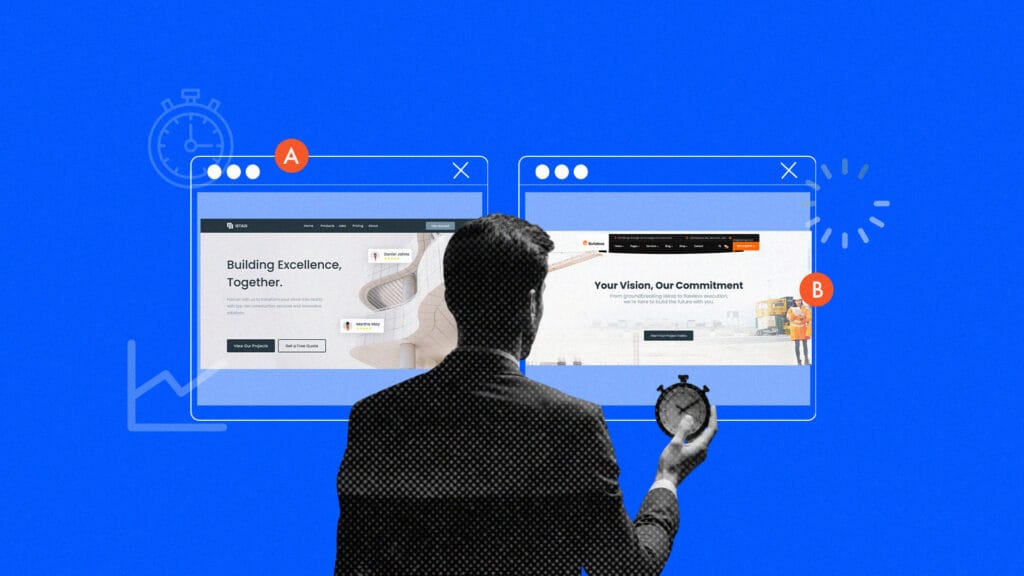When it comes to A/B testing, one very popular question a lot of marketers and product managers always ask is, “How long should this test last?” Of course, it’s a very valid question. After all, you don’t want to spend weeks—or even months—waiting for results that could have been clear days ago. On the flip side, you also don’t want to pull the plug too early, only to realize later that the “winning” version wasn’t actually a winner at all.
According to industry experts, the recommended A/B testing time is 2 weeks. But as you’ll see as this article progresses, determining the right duration for an A/B test isn’t always straightforward. It’s not as simple as setting a timer and calling it a day once it dings. Instead, it requires careful consideration of your goals, traffic patterns, and the nuances of your audience’s behavior. But don’t worry—this process doesn’t have to feel like rocket science. Let’s break it down together.
The implication of ending your test too early
Let’s start with a relatable story. Imagine this: You’re a product manager at a mid-sized e-commerce company, and your team is testing two versions of a checkout page. Version A is your current design, while Version B introduces a sleeker, simpler layout with fewer distractions. After just four days, your analytics dashboard shows a clear winner—Version B is outperforming Version A by 25%. Excited, you immediately roll it out to all users.
For the first week, everything looks great. Conversion rates are up, and the team is celebrating. But then, something strange happens. Sales dip back to their original levels and confusion sets in. Why didn’t the results hold up?
The answer? The test ended too soon. Those initial results were likely skewed by a small sample size, a temporary traffic boost, or even a specific audience segment that doesn’t represent your broader customer base. This is why patience and proper planning are all the more essential in A/B testing. Let’s explore why this happens and how you can avoid making the same mistake.
Why timing matters
Ending an A/B test too early is like judging a movie based on its trailer. Sure, you might get a sense of what’s happening, but you’re missing the full story. To truly understand the impact of your test, you need to give it enough time to capture the natural ebb and flow of user behavior.
Here’s why timing is so important:
1. Statistical significance isn’t instant
A/B testing is all about making data-driven decisions, and statistical significance is your guiding light. This measures the likelihood that your results are not just a fluke. Most experts recommend waiting until your test reaches at least a 95% confidence level before making any decisions.
However, reaching statistical significance depends on your traffic volume and conversion rates. If your site gets thousands of visitors per day, you might hit that threshold in a week. But if your traffic is lower, it could take much longer. Cutting the test short before you reach this point means risking decisions based on incomplete or unreliable data.
2. Accounting for business cycles
Ever noticed how sales tend to spike on certain days, weeks, or even seasons? That’s because consumer behavior often follows predictable patterns. For example, a retail site might see more conversions on weekends, while a B2B SaaS company might perform better during the workweek.
If your test doesn’t run long enough to cover at least one full business cycle, you risk missing these natural fluctuations. Ideally, you should aim to run your test for at least two cycles to ensure your results are representative.
Let’s say your average customer takes about two weeks to make a purchase decision. If you stop testing after just one week, you’re excluding users who are still in the consideration phase. This can lead to skewed results that don’t reflect the true impact of your changes.
3. Traffic sources and segments
Not all website visitors are created equal. Someone who clicks on a Facebook ad might behave very differently from someone who arrives through an organic search. Similarly, new visitors might react differently to your changes compared to returning customers.
If your test coincides with a big marketing campaign—say, a promotional email blast—it could inflate your results by attracting a surge of high-intent visitors. While this might feel like a win, it doesn’t necessarily reflect how your site performs under normal conditions.
To get a more accurate picture, it’s important to let your test run long enough to capture traffic from all your sources, not just the ones that happen to be active during a short window of time.
The danger of peaking early
Let’s talk about a common temptation: checking your test results too early.
As humans, we are very inquisitive in nature—and this inquisitiveness tends to extend into the world of A/B testing. While being inquisitive is one of the best traits of humanity, in this case, it’s actually one of the easiest ways to derail your experiment.
Imagine checking your results after just two days and seeing a 10% lift in conversions for one variation. It’s tempting to call it a win, right? But early results can be misleading. They’re often influenced by random fluctuations or noise in the data. Worse, if you react too soon and stop the test, you’re essentially locking in results that might not hold up over time.
Think of your test like baking a cake. If you pull it out of the oven too early, it might look good on the outside but still be raw in the middle. Similarly, your A/B test needs time to “bake” properly before you can trust the outcome.
How to determine the right test duration
Now that we’ve understood the nuances of timing in A/B testing, as well as the dangers of calling it an early win, how long should your A/B test actually run? The answer depends on a few key factors:
1. Traffic volume
The more traffic your site gets, the faster you’ll collect the data needed to reach statistical significance. Low-traffic sites will need longer test durations to achieve reliable results.
2. Conversion rate
If your baseline conversion rate is very low, it will take longer to detect meaningful differences between variations. This is because small changes require more data to show up as statistically significant.
3. Business cycles
As mentioned earlier, your test should run for at least one full business cycle—preferably two. This ensures you’re accounting for any seasonal or weekly patterns in user behavior.
4. Sample size
You can use online calculators to estimate the sample size needed for your test. Input your baseline conversion rate, desired lift, and confidence level, and the tool will tell you how many visitors are required for a reliable result.
All things considered
All things considered, A/B testing is one of the most powerful tools in your optimization toolkit, but it only works if you do it right. Cutting corners might save time in the short term, but it can lead to costly mistakes down the road.
Remember, the goal of A/B testing isn’t just to find a winner—it’s to find the truth. And the truth takes time. So, the next time you’re tempted to end a test early, take a deep breath and remind yourself: good things come to those who wait.
After all, wouldn’t you rather spend a few extra days testing than months undoing a decision based on faulty data?



